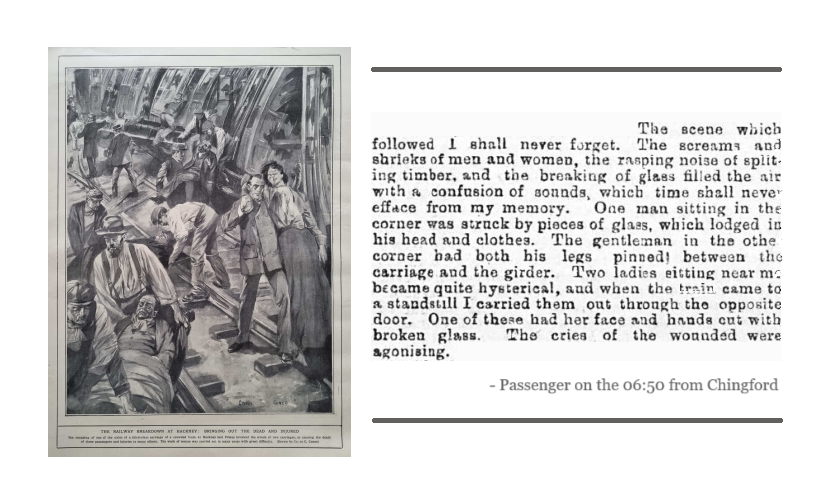
At 07:11 on 25th April 1902, a commuter train from Chingford bound for the London terminus at Liverpool Street derailed on the approach to Hackney Downs station. The resulting collision of carriages with a bridge support led to the deaths of four people and a further two hundred injuries. In this post, I take a look at this long-forgotten accident.
The Chingford line is just ten miles long, and was built and operated by the Great Eastern Railway (‘GER’). In 1902, as now, it was a busy suburban commuter route with modern rolling stock. Trains were one hundred and fifty yards long, comprised of fifteen 1st, 2nd and 3rd class carriages of mainly teak construction. Each carriage was twenty-seven feet long and had only four wheels, rather than bogies (US: trucks); 1st class carriages contained four compartments, 2nd and 3rd class five. To achieve maximum capacity the carriages were as wide as the track gauge allowed – the doors even needed to be recessed so the handles didn’t strike passing trains. As a result, each 3rd class compartment could hold twelve seated passangers. However, increasing passenger numbers meant trains were regularly overcrowded during peak times, particularly the 3rd class carriages on the last service of the morning on which thruppenny ‘workers fares’ were available: The 06:50 from Chingford. On this service, younger travellers would often climb into overhead luggage racks if there was no vacant seating or floorspace.
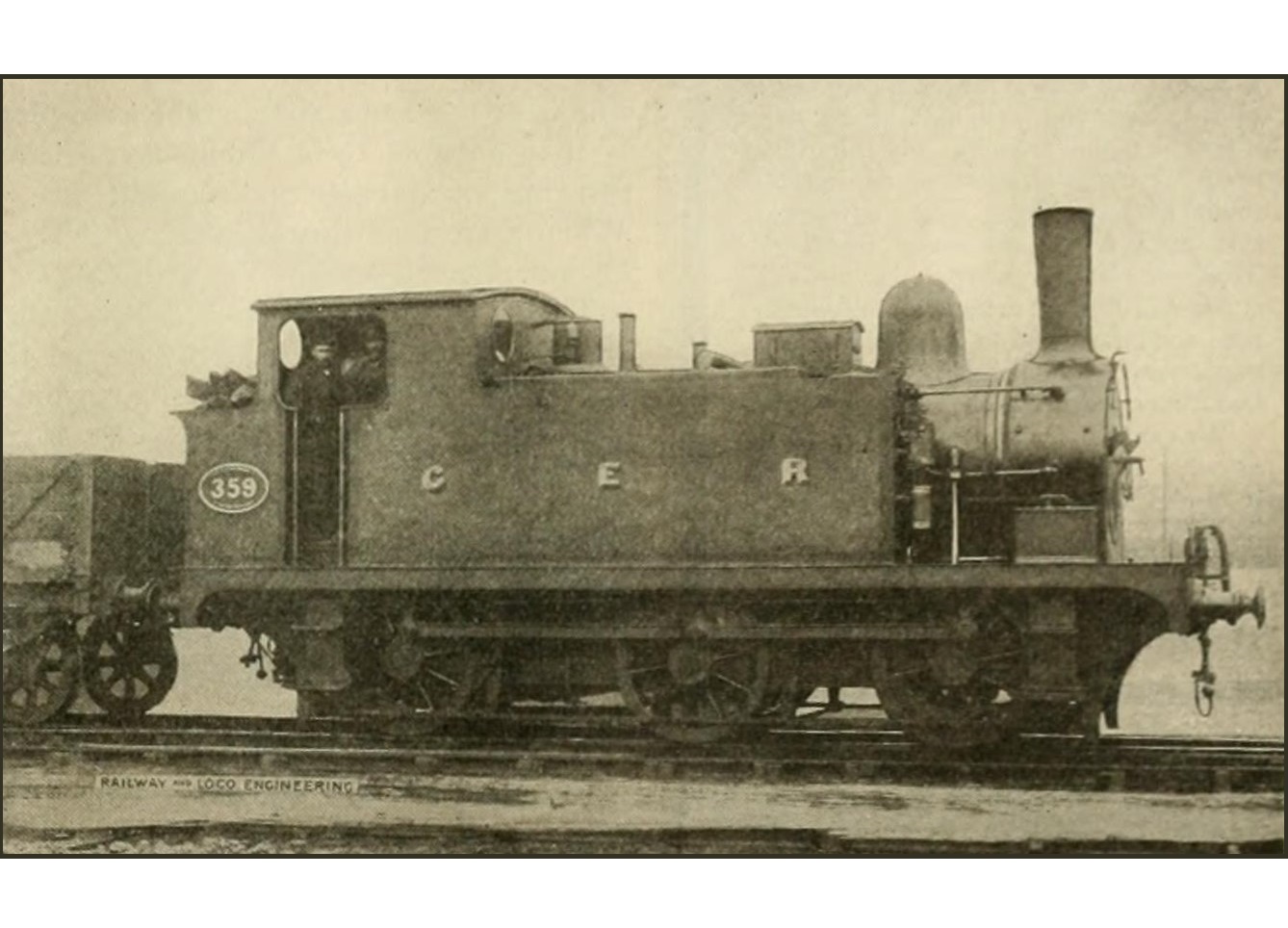
On that fateful morning the 06:50, pulled by a tank engine running ‘bunker first’ (backwards), had called at Highams Park, Wood Street, Hoe Street – now Walthamstow Central – and St. James Street. On departure from the next station, Clapton, it was estimated there were approaching seven hundred passengers on board, the majority crammed into the seven 3rd class carriages. One passenger later claimed his compartment was holding more than double the seated capacity.
← GER Class R24, the type of tank engine that pulled the 6:50am train on the fateful day.
The distance between Clapton and the next station, Hackney Downs, is just one mile. There are two tunnels, and as trains enter the second there begins a steep incline up to where another suburban route, the Enfield line, joins from the west. This junction is immediately followed by the four platforms of Hackney Downs, two ‘suburban’ for stopping services and two ‘through’ for express services.
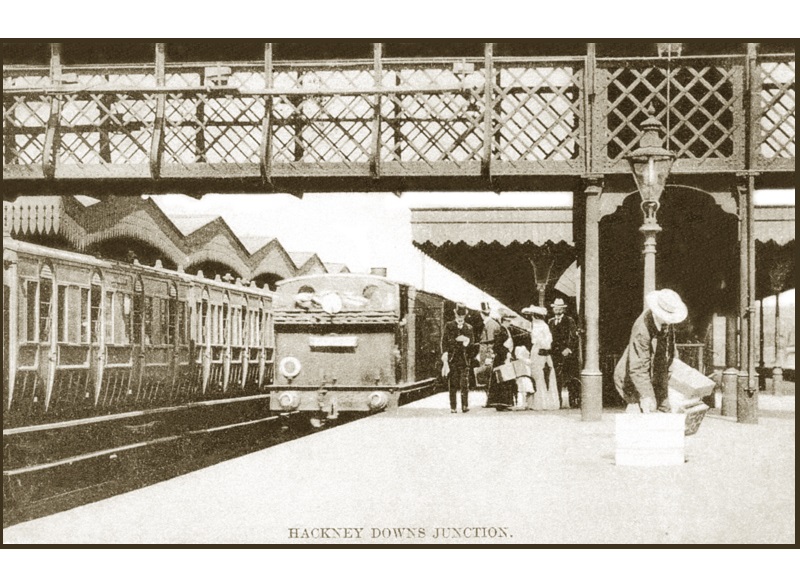
← An image of Hackney Downs station c.1905, showing the suburban platforms. The carriages on the ‘down’ line are of the type involved in the disaster; the nearer carriage with four doors is 1st class, the one behind is either 2nd or 3rd as it has five doors, the last hidden by the tank engine running bunker first on the ‘up’ line.
Just before the packed train emerged from the first tunnel the front axle on the third carriage broke. It was now around eighty seconds from disaster; the passengers in the affected carriage knew something was wrong but couldn’t alert the driver as the train wasn’t fitted with a communication cord. Initially, the front of the carriage dropped but was supported by the rear of the one in front. Just before the train entered the second tunnel, a platelayer standing next to Queens Road signal box saw what was happening and shouted at the signalman to alert his opposite number at Hackney Downs.
It was too late. Trains on the Chingford line approaching stations tended to maintain speed until the last moment and then brake hard; and on the inclined approach to Hackney Downs, drivers even had to increase speed. By the time the signal on the station approach was changed to danger, the driver had passed it. The train began to cross the junction at 07:11.
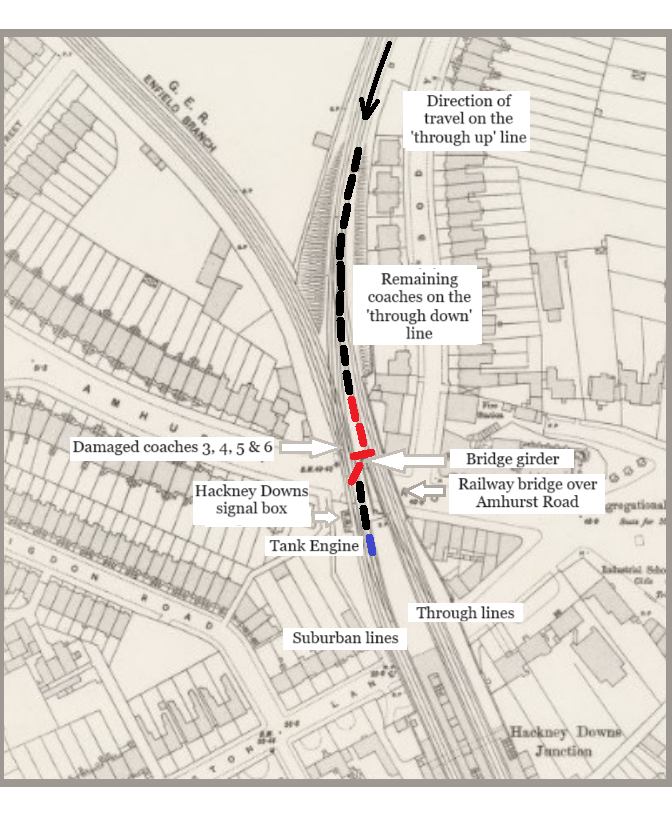
The train should have left the through up line, crossed the through down line and joined the suburban up line. The engine and first two carriages made it, but the broken axle struck the points and caused the third and fourth (both crowded 3rd class) to jump the tracks. As the train didn’t decouple they were dragged along between the suburban up and through down lines, pulling the remainder of the train onto the through down line. More platelayers working by the side of the line screamed at the driver, but within seconds – and in full view of passengers waiting on the platforms – the third carriage struck an iron bridge girder that rose five feet above the tracks over Amhurst Road. The left side of the carriage was ripped off. The fourth carriage detached from the third and hit the support broadside, crushing in its left side. This in turn caused the fifth and sixth (both 1st class) to topple over. As the third and fourth carriages parted, the train’s emergency brake system was triggered, and the engine and two front carriages came to a screaching halt opposite the signal box just outside the station.
← The approach to Hackney Downs, showing the final position of the 06:50 from Chingford. There seems to be no photographs of the disaster; the only illustration I have discovered is in the header, from a 1902 edition of Black and White magazine, by American-born illustrator Cyrus Cuneo. He lived in Hammersmith so it is unlikely this was painted ‘from life’.
Five doctors and numerous other medical staff attended the scene. Some passengers were trapped in the carriages. Crowds began to gather on Amhurst Road, from where they could see both the wrecked train above and the injured, brought down to road level through the station and sent to the nearby German Hospital at Dalston. Three died that day at the hospital. Of the ten most serious cases detained overnight, eight were from Walthamstow, and a relief fund for the injured organised by Walthamstow District Council was launched the same evening.
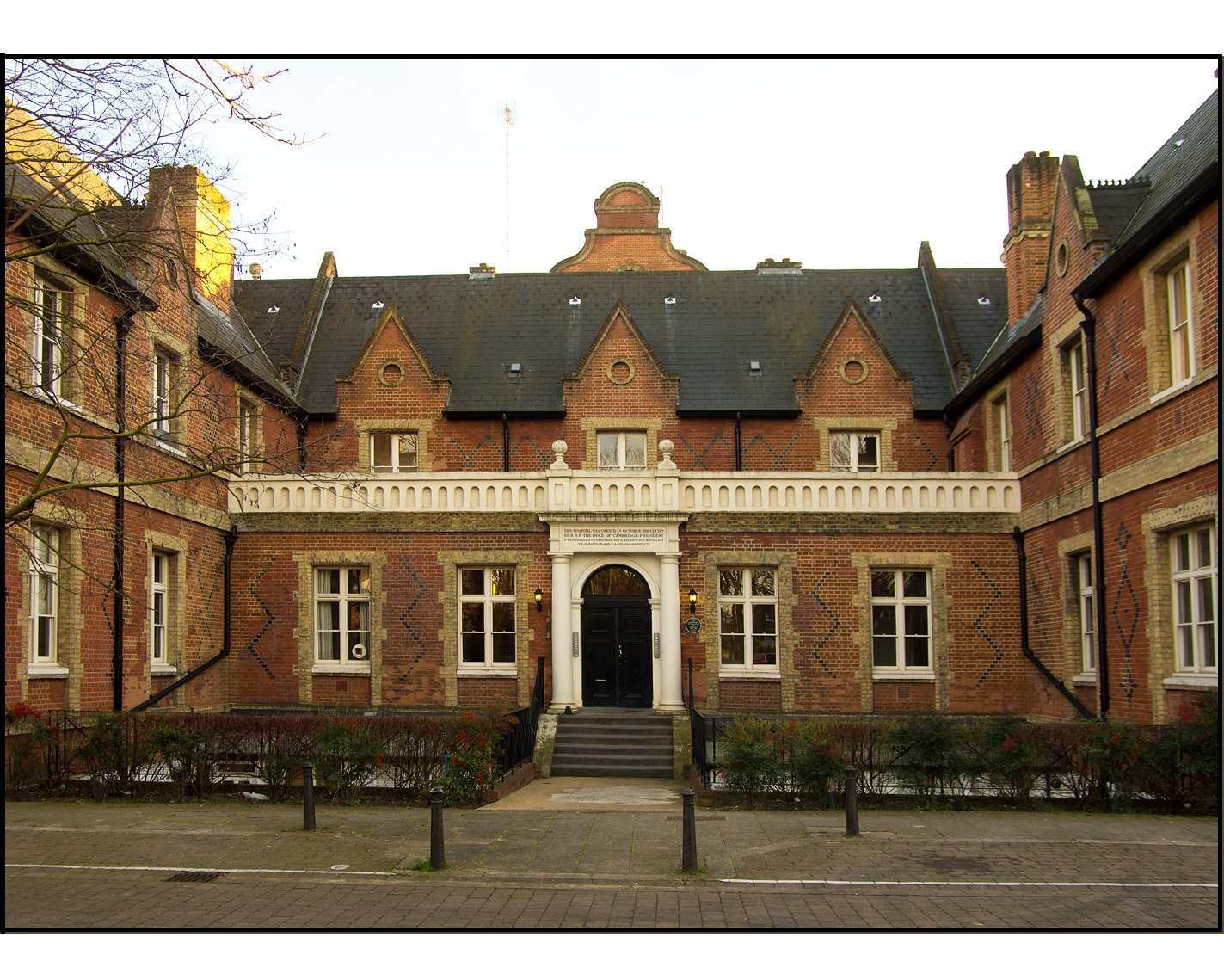
← Instead of Liverpool Street, the German Hospital in Dalston, shown after recent conversion into housing, was the destination of many passengers that day.
A few days later an inquest was opened at the Hackney coroner’s office but had to be adjourned and moved to Hackney council chamber due to the numbers trying to attend. Once it got under way, the three dead – all from Walthamstow – were named as Jessie Schultz, kitchenmaid, thirty-nine, of Cromer Road; William Gladley, forty-eight, a warehouseman of St John’s Road and William Richardson, forty-four, a printer of Valentine Road. It was stated that a flaw had been discovered in the failed axle, caused by a tiny pocket of air or contaminant unable to escape during the manufacturing process. Axles were expected to last twenty-five years; the flaw caused failure after just four months. Overcrowding was discussed, with local councillors describing it as a disgrace.
On 1st May the jury returned a verdict of accidental death, noting the disaster may have been prevented if the train had been fitted with a communication cord. At the time of the inquest, all ten seriously injured – including two boys who had been in the overhead racks and two teenagers who had legs amputated – were still in hospital, and the relief fund had raised £440. This total included £10 donated by the chairman of the GER.
A Board of Trade report written by Lieutenant Colonel von Donop, Royal Engineers, was published on 12th June. The broken axle was again identified as the cause; von Donop exonerated the company as he believed the defect could not have been detected by any means then available. The axle was stated to be one of a batch of one hundred, made of mild steel of ‘exceptional quality’ by Cammell. On delivery, two had been tested to destruction by the GER with satisfactory results. Just as the jury at the inquest had done, von Donop concluded that the disaster could have been averted if the carriage had been fitted with a communication cord, but the GER was under no legal obligation to do so as no distance between stations on the Chingford line was greater than twenty miles. However, von Donop stated that, despite this legal get-out clause, the company was “at present engaged in fitting the whole of their stock” with cords. Later newspaper correspondence conveniently suggests this had been decided by directors on 5th March, seven weeks before the accident.
Another inquest followed the death of William Garmey, fifty-two, master woodturner of Brookfield Avenue Walthamstow, some two months after the crash. He had been in the fourth coach and the compartment was so overcrowded a number of passengers fell on him at the moment of impact. Although he appeared uninjured and returned home after the crash, he rapidly suffered a series of debilitating health issues, and ultimately died as a result of a brain haemorrhage. The jury found this was “accelerated or caused by” the events of the 25th April. Garmey was, therefore, the fourth and final victim. All four had been travelling in 3rd class carriages.
A legal action followed in August. It was brought by Emma Gladley, widow of William Gladley. The jury found that there had been negligence on the part of the GER for not testing axles intermittently through their life, not providing communication cords, and allowing overcrowding. Mrs. Gladley was awarded £450, around £45,000 today. The GER was in a permanent financial crisis and a jury citing overcrowding in its judgement was setting a dangerous precedent, so it comes as no surprise that in February 1903 an appeal was heard. The original award was overturned and a new civil trial ordered. In the meantime the GER provided the widow with ten shillings per week – around £50 today. I can find no record of the retrial, but it seems likely the GER was victorious as by September 1906 Mrs. Gladley was receiving poor law relief, being permanently disabled through heart disease. She died six months later, and is buried with her husband in Walthamstow cemetary.
There is no memorial at Hackney Downs commemorating the dead. The events of that spring morning occurred in an era when fatal train crashes were, if not frequent, certainly more common than they are now. This was far from being the worst of the period – despite providing one of the highest number of injuries in UK railway history – and was quickly forgotten. Within hours of the accident the surviving carriages were standing in sidings at Clapton, the damaged carriages and debris stored at Stratford, and the track repaired. The through lines reopened just before 1pm, the surburban lines an hour later. For workers returning on the Chingford line from London that evening, it was as if the disaster had never happened.
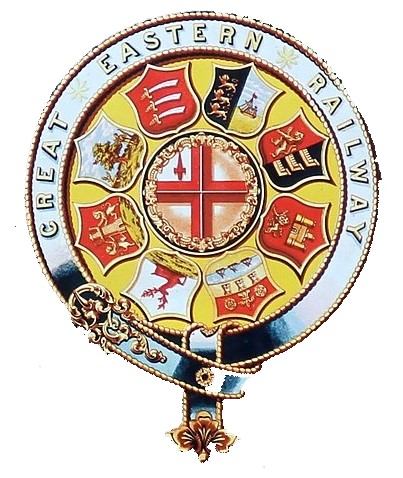
Nearest Stations: Clapton, Hackney Downs, Hackney Central (now all part of the London Overground network).
Selected Bibliography:
Credits: